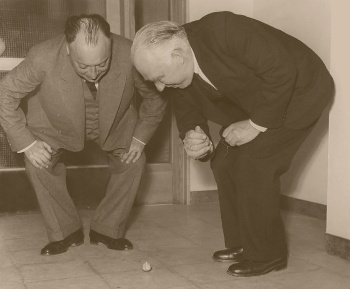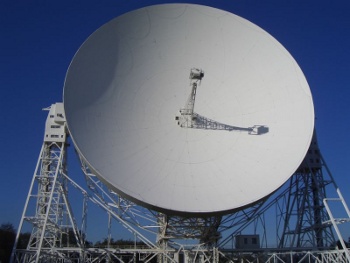Neutrino Mass
March 5, 2014
Beta decay, in which an
atomic nucleus is bumped up one
atomic number by the emission of an
electron (or
positron), was an early crisis in
elementary particle physics. The problem was that this
radioactive decay process violated the well-known
conservation laws of physics (
energy,
momentum, and
angular momentum).
Physicists weren't about to abandon their beloved, and useful, conservation laws that easily, so
Wolfgang Pauli had the idea that there was another, unobserved,
neutral particle emitted in beta decay. He called this particle the neutron, but this name was usurped by the
nuclear neutron, which was discovered just two years later.
Enrico Fermi later named the presumably smaller Pauli particle the
neutrino, or little neutron.
Pauli proposed the neutrino in 1930, but this weakly-interacting particle wasn't detected
experimentally until 1956. It's also interesting that the experiment itself was not detected by the
Nobel Prize committee until 1995, when the
Nobel Prize in Physics was awarded to
Frederick Reines (1918-1998) for this experiment. Unfortunately, his collaborator on the experiment,
Clyde Cowan Jr (1919-1974), had died before that time, and the Nobel Prize is never awarded posthumously.

"But, Niels, how is the angular momentum conserved?"
Wolfgang Pauli (1900-1958), left, and Niels Bohr (1885-1962), right, examining the operation of a tippe-top toy in Lund, Sweden, in 1954.
(Photo by Erik Gustafson, via Wikimedia Commons.)
When the neutrino was discovered, it was thought to have zero
mass, but such an elusive particle could hardly be detected, let alone allowing itself to be weighed. Massless neutrinos were never thought to be a problem, until the
Homestake experiment of
Raymond Davis, Jr.
As I wrote in a
previous article (Bacterial Iron Isotopes, July 22, 2013), this experiment, located nearly a
mile underground in the
Homestake Mine in
Lead, South Dakota, was designed to detect
solar neutrinos.[1-2] When the data were in, Davis had detected just a third of the neutrinos predicted by
Hans Bethe in 1939.[3] This experiment gave birth to the "
Solar neutrino problem."
The reason for the discrepancy was that Davis' experiment was designed to detect just
electron neutrinos, but these neutrinos had transformed into a mixture of electron,
mu, and
tau neutrinos on their travel from the
Sun to
Earth. This
neutrino "flavor" oscillation is only possible if neutrinos have mass; and, additionally, if they have different masses.
At this time, the best guess is that the sum of neutrino masses should be less than about 0.3
eV, as derived from various
cosmological constraints.[4] For comparison, the
electron mass is 0.510998928 MeV, and the
proton mass is 938.272046 MeV.
Richard A. Battye of the
Jodrell Bank Centre for Astrophysics,
University of Manchester (Manchester, UK), and
Adam Moss of the
Centre for Astronomy & Particle Theory,
University of Nottingham (Nottingham, UK), have recently refined this estimate using measurements of the
cosmic microwave background radiation from the
Planck spacecraft, along with
gravitational lensing observations.[5-7]
Battye and Moss sought an explanation for the observed distribution of galaxies in the
universe. They show that the large-scale structure of the universe can be explained if the sum of masses of neutrinos is 0.320 ± 0.081 eV.[7] This is the closest estimate yet for neutrino mass.

The Lovell Telescope at the Jodrell Bank Observatory.
Richard Battye is at Jodrell Bank.
(Photograph by Mike Peel, Jodrell Bank Centre for Astrophysics, University of Manchester, via Wikimedia Commons.)
Says Richard Battye,
"We observe fewer galaxy clusters than we would expect from the Planck results and there is a weaker signal from gravitational lensing of galaxies than the CMB would suggest. A possible way of resolving this discrepancy is for neutrinos to have mass. The effect of these massive neutrinos would be to suppress the growth of dense structures that lead to the formation of clusters of galaxies."[7]
References:
- Raymond Davis Jr. - Solar Neutrino Experiments, Brookhaven National Laboratory Web Site.
- Solar Neutrinos Are Counted at Brookhaven, Bulletin Board, vol. 21, no. 36 (September 14, 1967), Brookhaven National Laboratory Public Relations Office (PDF File).
- H. A. Bethe, "Energy Production in Stars," Physical Review, vol. 55, no. 5 (March, 1939), p. 434-456.
- Ariel Goobar, Steen Hannestad, Edvard Mortsell and Huitzu Tu, "The neutrino mass bound from WMAP-3, the baryon acoustic peak, the SNLS supernovae and the Lyman-alpha forest," arXiv Preprint Server, May 29, 2006. Also available as Ariel Goobar, Steen Hannestad, Edvard Mörtsell and Huitzu Tu, "The neutrino mass bound from WMAP-3, the baryon acoustic peak, the SNLS supernovae and the Lyman-alpha forest," Journal of Cosmology and Astroparticle Physics, vol. 2006, no. 6 (June 2006), pp. 19ff..
- Richard A. Battye and Adam Moss, "Evidence for Massive Neutrinos from Cosmic Microwave Background and Lensing Observations." Physical Review Letters, vol. 112, no. 5 (February 7, 2014), Document No. 051303 [5 pages].
- Richard A. Battye and Adam Moss, "Evidence for Massive Neutrinos from Cosmic Microwave Background and Lensing Observations." arXiv Preprint Server, January 7, 2014.
- Massive neutrinos solve a cosmological conundrum, Manchester University Press Release, February 10, 2014.
Permanent Link to this article
Linked Keywords: Beta decay; atomic nucleus; atomic number; electron; positron; elementary particle physics; radioactive decay; conservation laws of physics; conservation of energy; conservation of momentum; conservation of angular momentum; physicist; Wolfgang Pauli; neutral electric charge; nuclear; neutron; Enrico Fermi; neutrino; experiment; experimental; Nobel Prize; Nobel Prize in Physics; Frederick Reines (1918-1998); Clyde Cowan Jr (1919-1974); angular momentum; conservation law; Niels Bohr (1885-1962); tippe-top; Lund, Sweden; Wikimedia Commons; mass; Homestake experiment; Raymond Davis, Jr.; mile; Homestake Mine; Lead, South Dakota; solar neutrino; Hans Bethe; Solar neutrino problem; electron neutrino; Muon neutrino; Tau neutrino; Sun; Earth; neutrino "flavor" oscillation; electronvolt; eV; cosmology; cosmological; electron mass; proton mass; Richard A. Battye; Jodrell Bank Centre for Astrophysics; University of Manchester (Manchester, UK); Adam Moss; Centre for Astronomy & Particle Theory; University of Nottingham (Nottingham, UK); cosmic microwave background radiation; Planck spacecraft; gravitational lens; gravitational lensing; universe; Lovell Telescope; Jodrell Bank Observatory; galaxy clusters.